The 2023/24 season was not a lot of fun for most teams in the midfield of Liga Portugal, with over half the league being in the relegation battle for the majority of the campaign.
One of the clubs caught up in this mess was Famalicão, a rather small club in the north of Lisbon.
The club has made a name for itself after being promoted in 2019 by finishing sixth in their inaugural season in the Portuguese top flight and not finishing in the bottom half of the league since the promotion.
During this time, a lot of bigger names went through the ranks of the club, with the likes of Uroš Račić, Toni Martínez, Otávio, Pedro Goncalves or Manuel Ugarte leaving the club after a short period of time there for bigger opportunities.
In March 2024, being just three points ahead of the relegation play-off place 16 in the table, Famalicão decided to fire their coach, João Pedro Sousa, and hire Armando Evangelista to give the team another spark to finish the season.
And boy, oh boy, did that work.
During the last nine games of the season, FC Famalicão scored 14 points, as many as big FC Porto did, and managed to finish the season in eighth place.
Like every year, the team faced their star players leaving the club.
Winger José Luis Rodriguez transferred to Red Star in Serbia, Captain and top goalscorer Jhonder Cadíz made a permanent move to Mexico, and just this week, FC Villarreal picked up Famalicão’s goalkeeper Luiz Júnior as a replacement for Filip Jörgensen, who made the big move to Chelsea FC.
Still, the team managed to beat heavily favoured Benfica and Roger Schmidt 2-0 on matchday 1 and convincingly beat CF Estrela 3:0 in the second game, putting the club in joint-second place with FC Porto in these early stages of the campaign.
But how did Armando Evangelista preserve the momentum the team gained at the end of last season?
In this tactical analysis, we will take a look at the tactics used by the Famalicão coach and provide an analysis of what we can expect from the team moving forward into the season.
Armando Evangelista formations At Famalicão FC
Armando Evangelista is not a friend of change.
During his now 11 games with FC Famalicão, he’s always used the 4-2-3-1 as his base formation, as he did with pretty much all of his former clubs.
The goalkeeper position underwent a change during these first two games, with Ival Zlobin rotating into the starting eleven for Luiz Júnior, who was on the verge of leaving the club and finalising his move one day after the game.
The rest of the starting XI stayed the same during these two games to start the season for FC Famalicão.
The back four consists of Justin de Haas and Enea Mihaj starting as the two centre-halves with captain Francisco Moura starting at left-back and loanee Lucas Calegari starting at right-back.
In midfield, the double pivot consists of holding midfielder Mirko Topić partnered with box-to-box midfielder Zaydou Youssouf, who plays a more advanced role.
In offence, Evangelista trusts 19-year-old Gustavo Sá as his playmaking number 10, with new signings Rochinha, who came from Trabzonspor, and Sorriso, loaned out from the Brazilian Red Bull Bragantino, playing on the wings.
Up front, young Spaniard Óscar Aranda has been starting both games for Evangelista in his second season at Famalicão, joining them from Real Madrid last summer.
Other notable reinforcements during the summer transfer window for the club are 28-year-old Spanish striker Mario González and 21-year-old right-back Rodrigo Pinheiro, who was brought in from FC Porto’s B-team.
Overall, the team had to replace the offensive firepower that left them.
Jhonder Cádiz, who scored 15 goals last season, was a vital player for Famalicão, so the offence had to undergo quite some changes during this preseason.
Defending well all over the pitch
One thing that stands out during Armando Evangelista’s tenure at Famalicão is the defensive prowess of his team.
In 11 games under Evangelista, FC Famalicão have only conceded 11 goals, and they have not conceded a single goal in the two games they have had so far this season.
There are many things that Evangelista‘s men are doing exceptionally well on the pitch, but to start off, we are going to examine how the team defends from a tactical standpoint.
One thing that stands out about Famalicão this season is their ability to defend all over the pitch.
They can play with a very high pressing line and defend deep in their own territory against teams that dominate possession.
They can survive phases of play where they face a lot of pressure without conceding many goalscoring chances.
In terms of tactics, Evangelista uses his 4-2-3-1 formation in a different way than you would expect.

As pictured above, attacking midfielder Gustavo Sá pushes up the field against the ball, forming a 4-4-2 shape.
Sá sometimes even plays ahead of the actual striker, Aranda.
If we look at the Famalicão players, one thing stands out: All of them are facing forward, orienting themselves forward towards the ball.
Most of the time, Famalicão triggers the press by one of the strikers attacking the opposing team’s ball-carrying centre-back.
In the example above, Sá attacked Estrela’s left centre-half, who was forced to pass the ball to the other centre-half.
Aranda is already waiting for that pass to attack the centre-back before he even receives the ball, cutting off the play to the left side.
However, if we look at the picture, there is a lot of space left uncovered between the lines to exploit.
The centre-back does well playing a pass through the first pressing line of Famalicão, finding his midfielder.
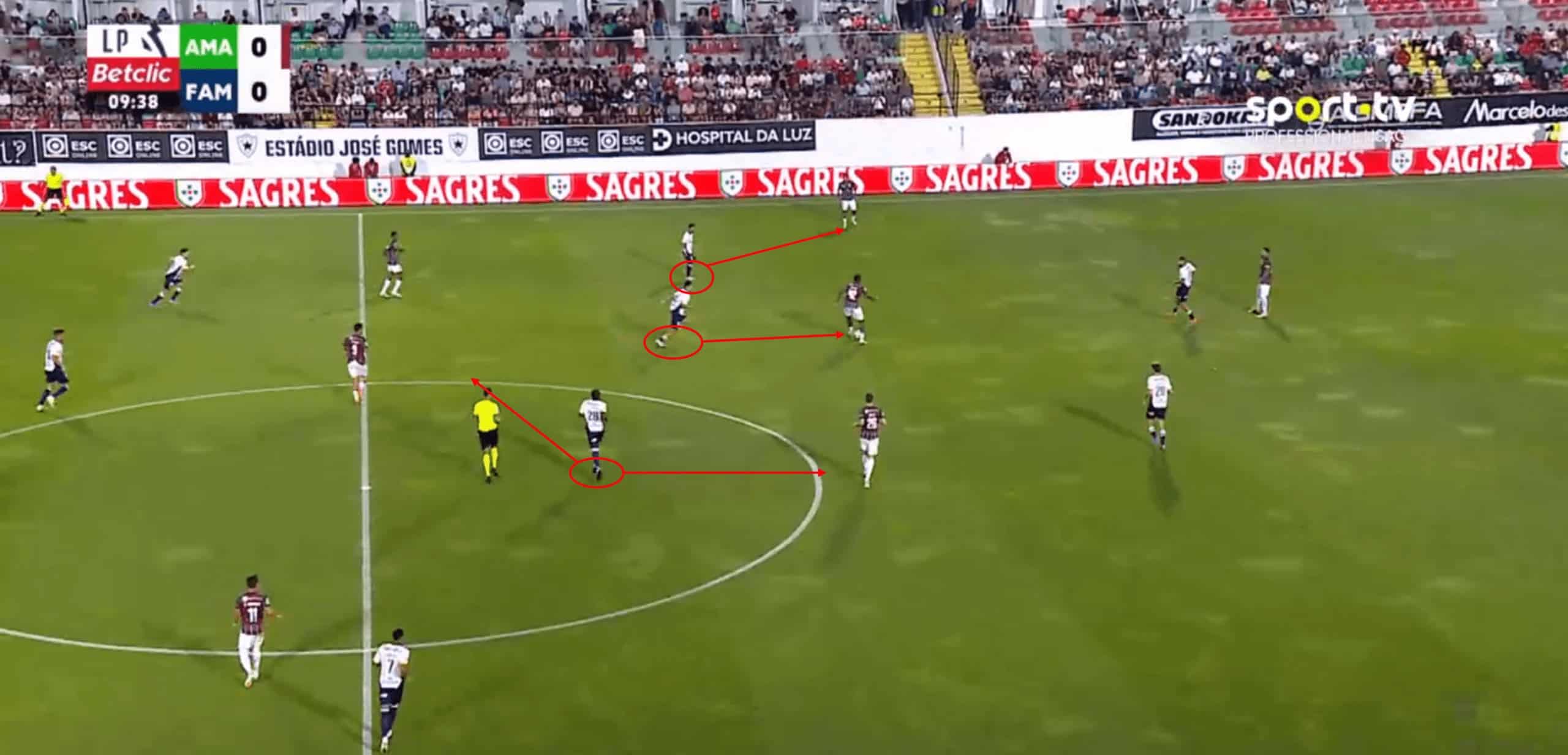
While it looks like a good idea at first, the midfielder is not able to turn his body, because Topić behind him is defending on his front foot, a term we will see a lot today and I will explain in greater detail later.
Instantly, Famalicão is able to put pressure on the ball, because every passing option is being controlled by a defender, able to instantly move forward and press after the pass is played.
In this situation, Estrela can only play a long ball that their strikers cannot receive, allowing Evangelista’s men to retrieve the ball quickly.
This demonstrates many of the basic principles that make them such a defensive force.
High press
As already pictured in the last example, FC Famalicão are trying to start pressing the opposing backline deep into the opposition’s half.
Pressing is always a bit of a risk, especially if you are pressing this high.
For the press to actually work, good coordination is very important.
Usually, there are tasks awarded to players varying on how near the ball is to them.
The closest players attack the ball and take away passing options, those with a middle distance to the ball are supposed to cover their backs, and the far-sided players are supposed to control the depth of the field and react to switches.
This is a very broken-down way of describing it.
Many coaches, especially those from the Red Bull coaching tree, spend a lot of time determining these tasks for their players to commit to.
Every coach who wants his team to play a high press has one thing in common: They encourage front-foot defending, which is actually a relatively easy-to-understand concept.
Every player needs to be able to press forward at any given time, for example, after a pressing trigger.
Traditionally, football is a game where coaches try to minimise risks.
Defending the centre of the pitch over the wings and defending the depth of the pitch are two of the basic principles every single player at any level is taught from the beginning of their career onwards at every opportunity.
However, if you want to press in football, you will need your team to have an aggressive mindset, defend forward, ignore the space behind them, trust their teammates to do the same and cover for their teammates.
FC Famalicão, under Armando Evangelista, have been great at doing exactly that.
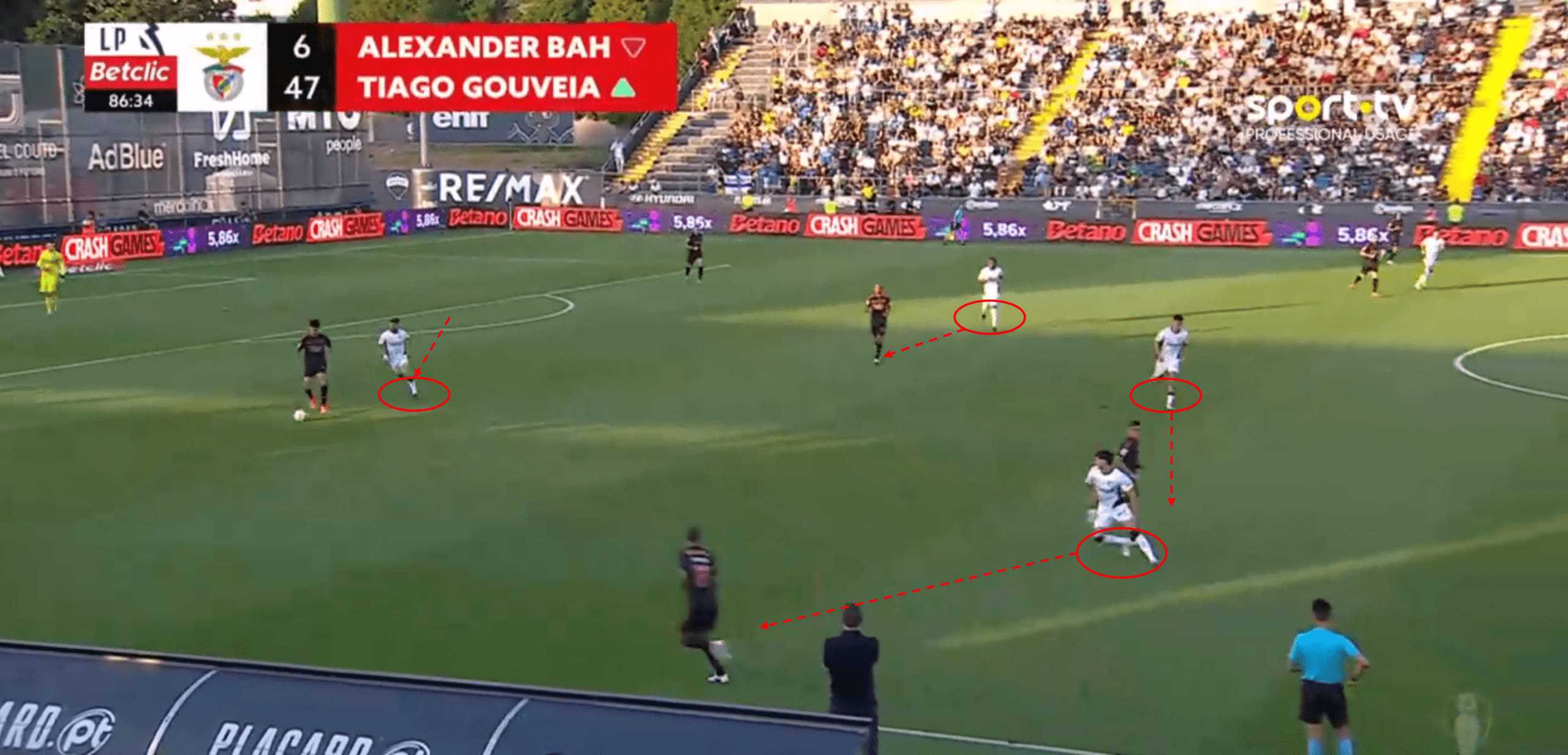
Here, we have an example from the game against Benfica.
Mind yourselves that Famalicão was the underdog here, and yet they are still pressing this high, with a one-goal lead in the 87th minute of the game.
The striker makes a run from the centre of the pitch towards the centre-back, cutting off the play once again and putting pressure on the build-up right away.
If we look at the other Famalicão players near the ball, we can see that they are all defending on their front foot, looking to cover all the passing options in a man-oriented way on the left defensive side.
All of them are looking at the ball, waiting for the pass to be played, triggering the press, and aggressively pressing forward onto Benfica’s right-back.
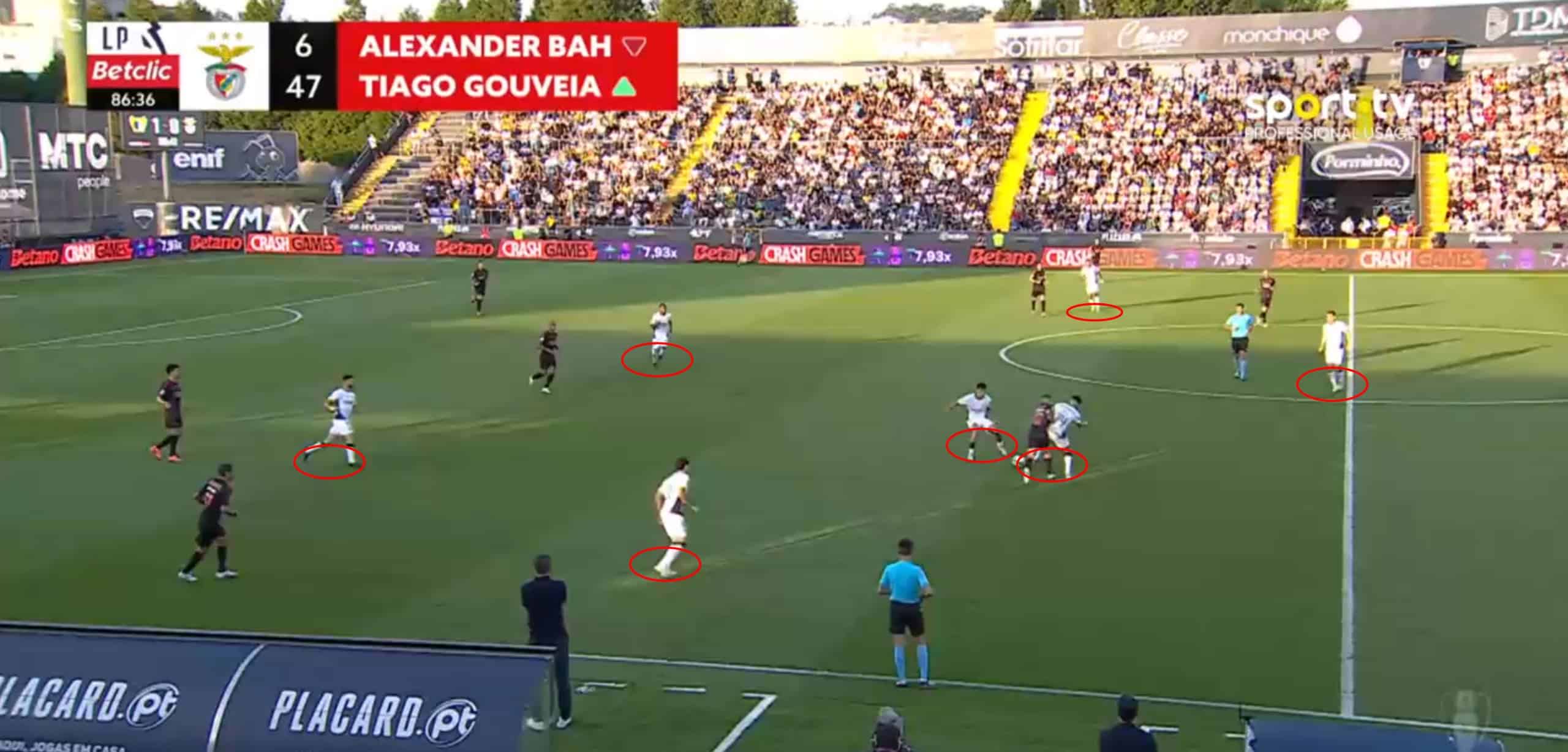
This leads to this situation: the four Famalicão players pressured Benfica into a mistake, playing the ball into the centre of the field.
There, Famalicão has seven players who are closer to the ball than the next Benfica player who does not have the ball yet.
Not only are they able to get pressure, Topić, who was tasked with defending the depth behind the four pressing players, reads the situation well and allows a 2v1-tackling against the Benfica player, who has zero chance of doing something with the ball right there.
Unfortunately for Famalicão, Topić can’t control the ball after his tackling, and Joao Mario is able to recover the loose ball for Benfica and play a quick pass to the left side, where Evangelista‘s men are vulnerable; they wanted to cut that pass off from the start.

But once again, Famalicão is defending on the front foot.
Right back Pinheiro does not hesitate to move forward instantly and press the Benfica attacker when he receives the ball.
This leaves space uncovered behind him, yes, but there is no way that the Benfica attackers are able to exploit that with that much pressure on them.
The entire area is crowded with Evengelista’s men, which leads to them being able to recover the ball easily and start the counterattack.
This front-foot defending put pressure on every single Benfica player who touched the ball in this sequence, leading to three tackles and one recovery for Famalicão before Benfica was even able to reach their half.
This is a perfect example of how their aggressive mindset is making their defence extremely strong.
Defending in modern football starts up front, and Armando Evangelista has implemented those ideas into the team this season.
FC Famalicão is leading the league in both defensive duels and interceptions, showing that their hard work is paying off.
Crowding the ball
While defending starts up front — and that clears up the whereabouts of defending — the question of when arises as well.
We have talked about the pressing trigger of Famalicão with the striker cutting off play and forcing a pass to one side of the field; Evangelista has also implemented a very strong counterpressing at Famalicão.
The moment the team loses the ball, it does not fall back; no, it crowds the ball and relentlessly attacks the opposing team.
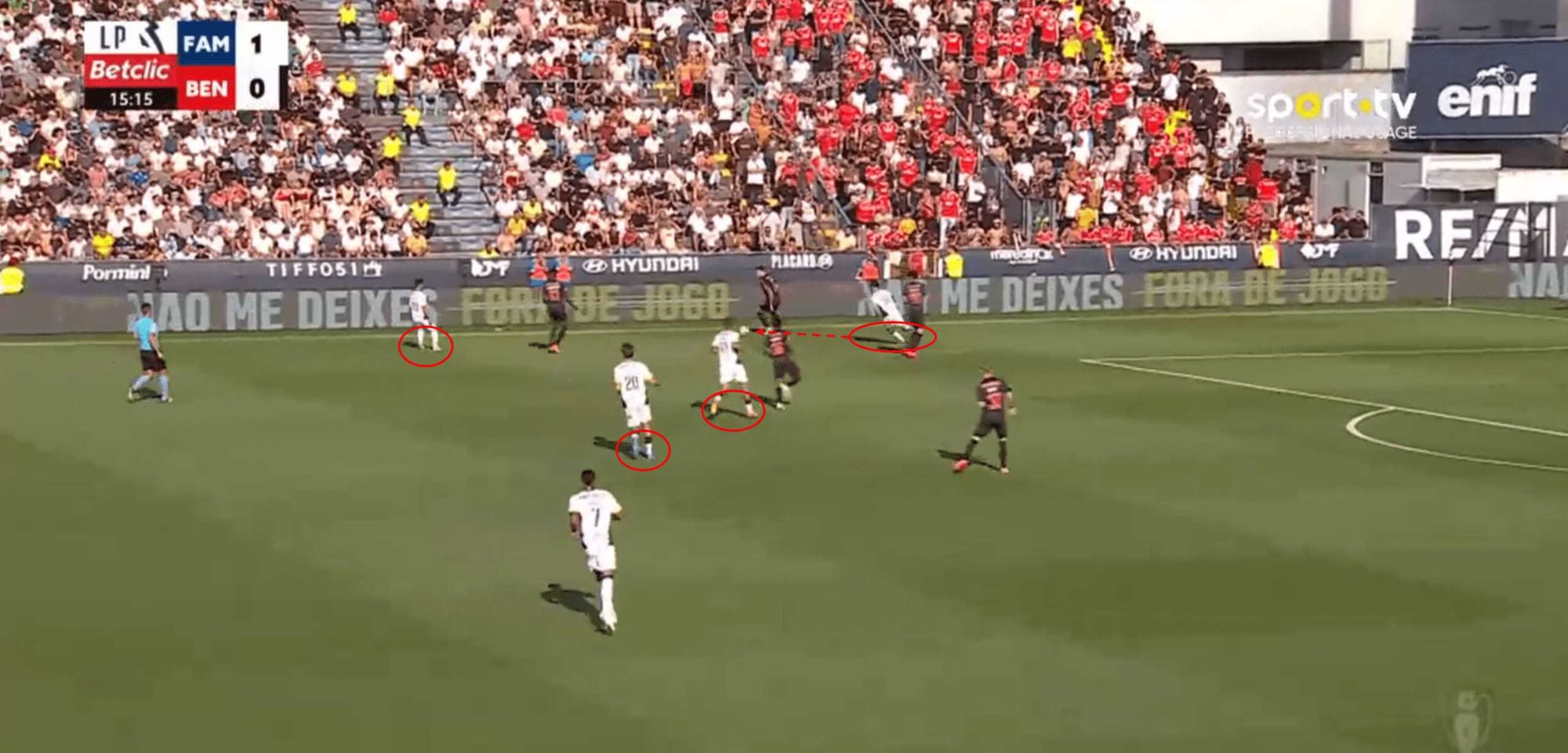
Here, left-back Moura loses the ball in a take-on-attempt up the field.
Due to their narrow positional play, the Famalicão attackers are already in a very good position to attack the ball.
Without losing a tenth of a second, Moura turns around and attacks the Benfica player with the ball, allowing his team to help him out quickly.
Once again, not a single player hesitates or looks backwards. They all have eyes on the ball and are collectively pressing forward.
In this situation, they force a pass back to the Benfica goalkeeper, but the press does not stop there.
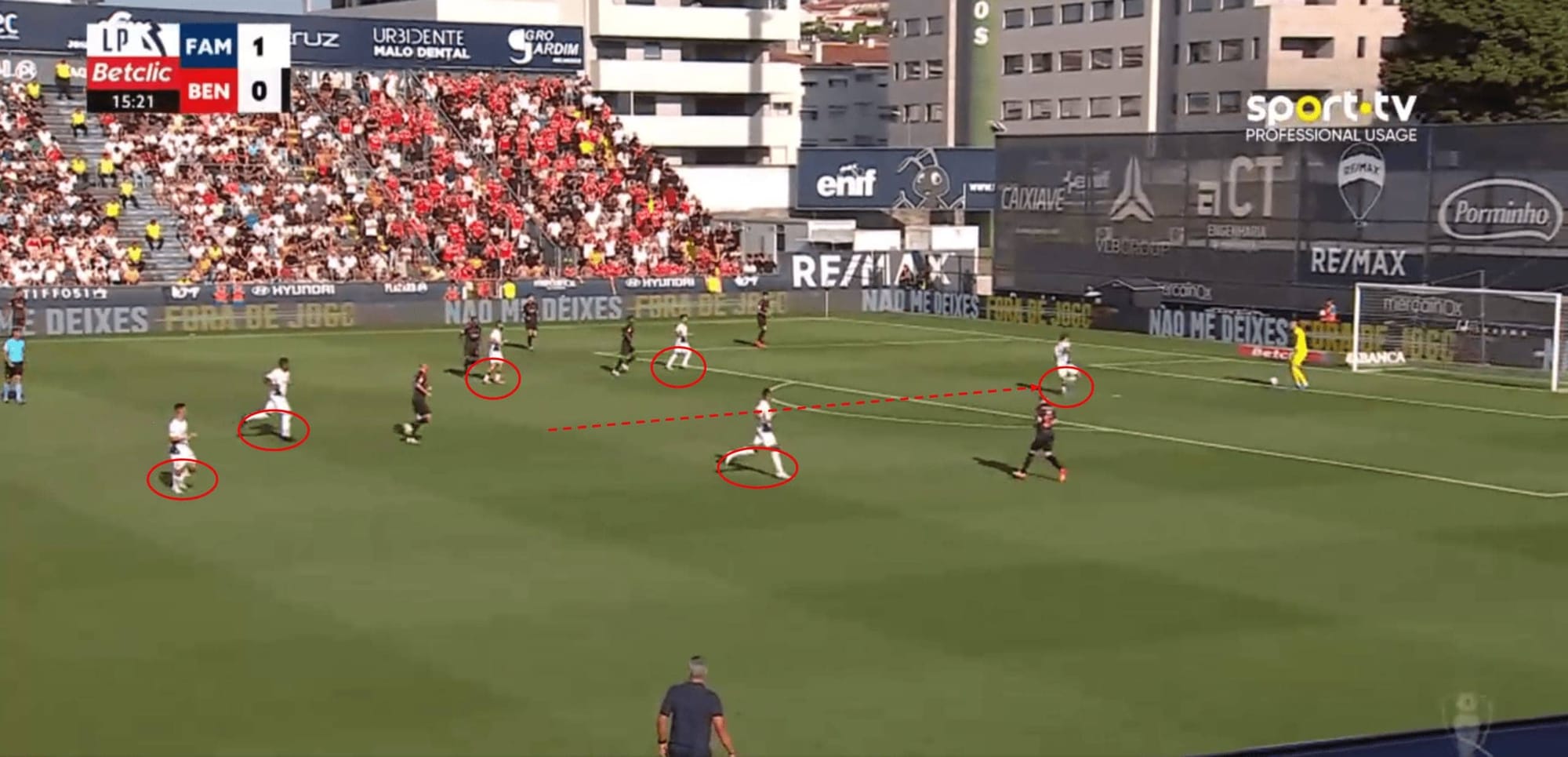
After the backward pass, Sá instantly runs towards the goalkeeper, forcing him to hit a long ball down the field without having an actual target.
This allows the Famalicão defenders to easily win the aerial and recoup the ball quickly after losing it.
If we are talking about positional play in attack, there is a principle called „as much depth as possible, as wide as needed“.
This simply means that if you want to be a good counterpressing team, you will need to mind the press even while in possession.
If we take a look at the pictures, Evangelista‘s men are never using the entire width of the pitch; they are rather focused on being close to each other so that after the team loses the ball, multiple players are able to get to the loose ball immediately and can pressure the ball carrier before he can have a controlled action.
And, for the 100th time today, all Famalicão defenders are on their front foot, ready to engage in counterpressing right after losing the ball.
If just one player hesitates, Benfica will be able to progress through the press rather easily, taking three or four players out of the equation, but if a team has the collective trust to pull it off as Famalicão does, that is impossible.
Pressing tasks and where to find them
This paragraph is just going to be a very short introduction to a topic that can be insanely interesting and time-consuming: The pressing tasks I have talked about before.
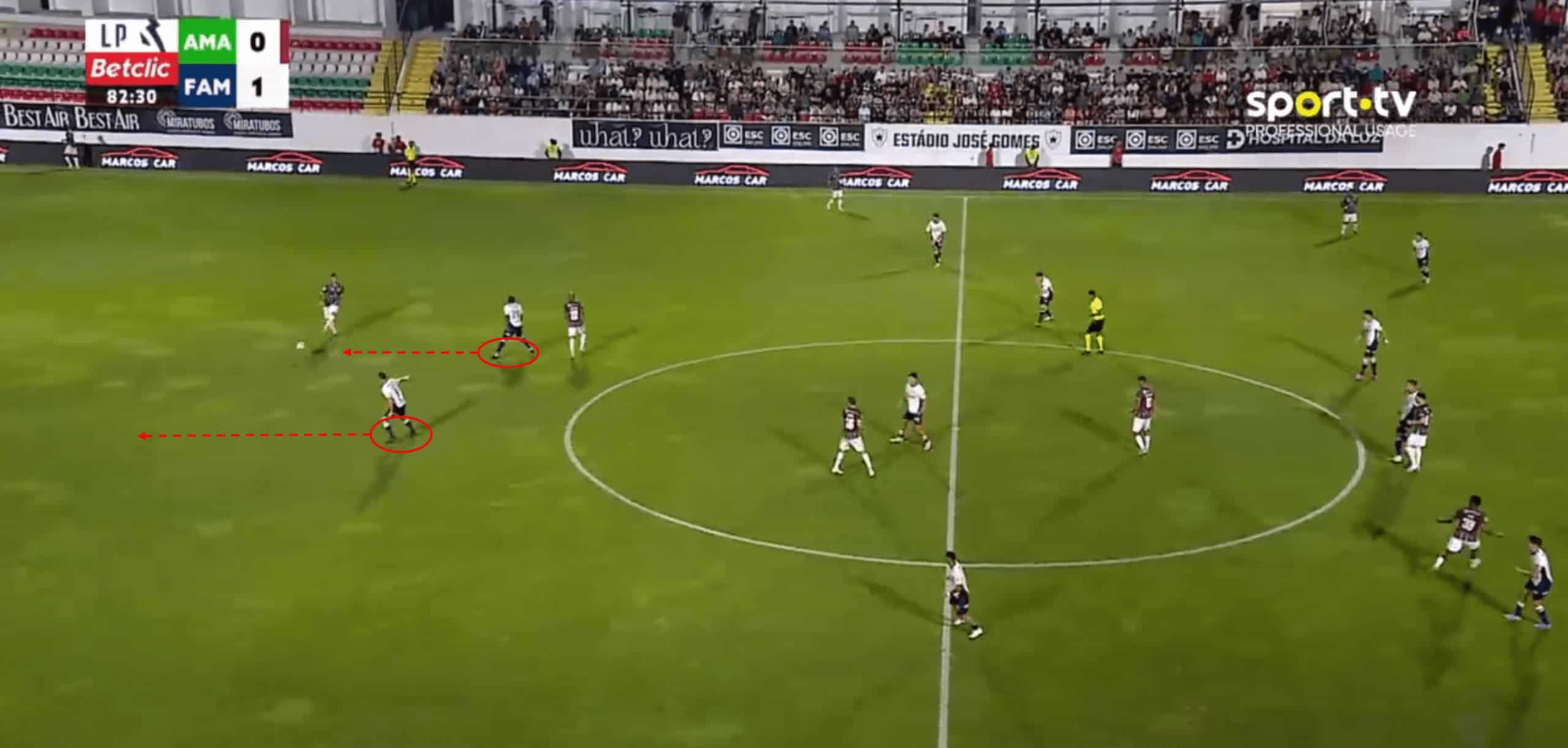
Here, we have a situation out of the game against Estrela.
Estrela is also playing with a 4-4-2, but the full-backs are pushing forward, and one midfielder is dropping deep, which should give them a numbers advantage with their three-man build-up against the two strikers in Famalicão’s first pressing line.
Youssouf, who was playing as the attacking midfielder in the closing minutes of the game, is pushing up to create the 4-4-2-shape for Evangelista’s men here again.
Youssouf then triggers the press by attacking the centre-back while his face is turned to the inside, allowing him to only play a pass towards the other centre-half. This is the pressing trigger we have seen multiple times now.
And once again, Gonzáles is cutting off the play for Estrela, forcing a pass out towards the right-back-
Famalicão is obviously ready for this pass being played, every player is on his front foot, the press is being triggered here.
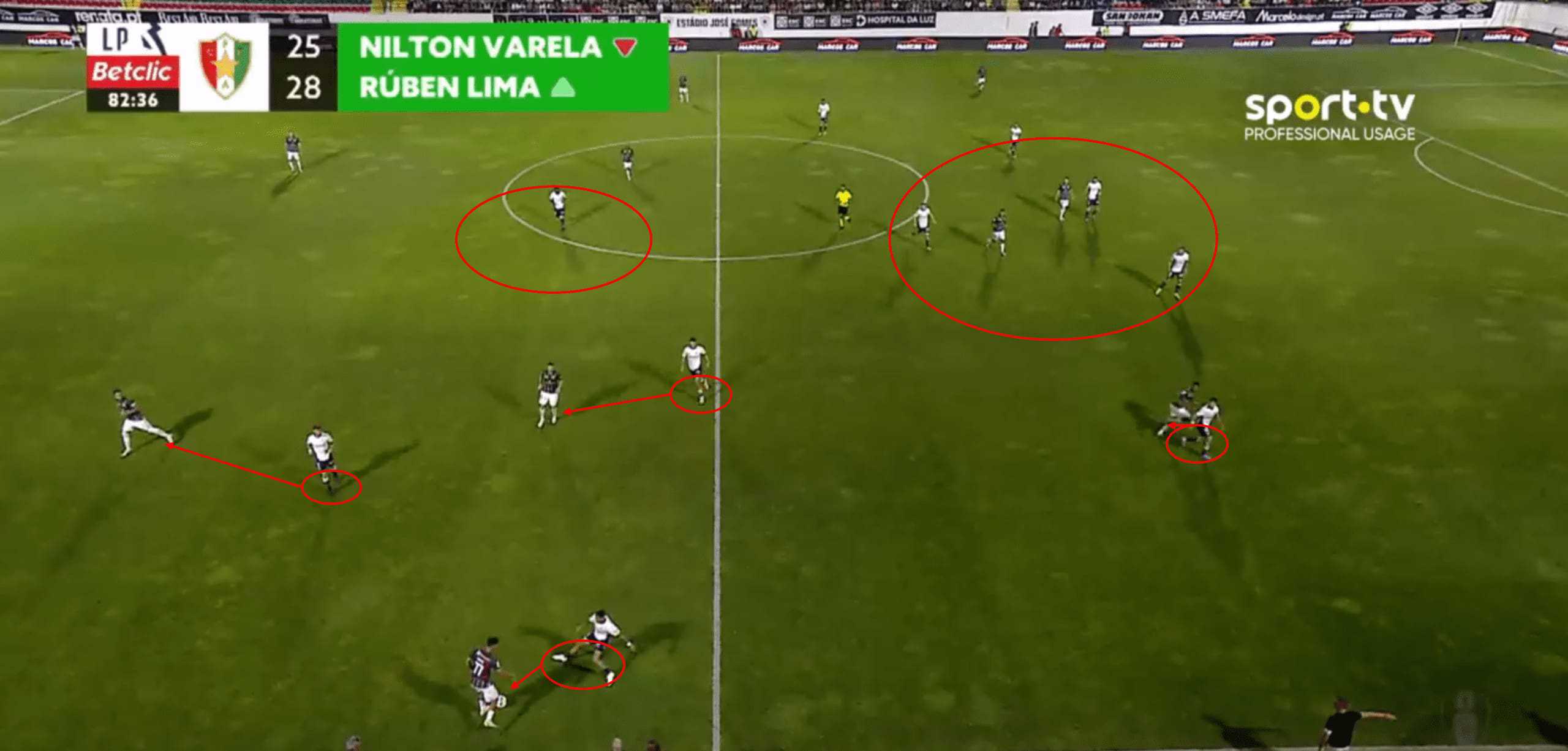
I’ve chosen this situation for two main reasons.
The first reason is to show the different pressing tasks Evangelista has given his players.
Mario Gonzáles, after forcing the pass outwards, is controlling the right centre-back to prevent the one-touch-pass back to the centre-back, cutting off the passing option.
The left winger Dias is instantly pressing the ball after the right-back receives the pass.
Midfielder Topic is pushing up the field, cutting off the passing option towards the holding midfielder of Estrela with the left-back Moura covering the depth behind those two.
After triggering the press, Youssouf controls the centre of the pitch, preventing a switch to the far-sided midfielder or the left centre-back.
The rest of the team is covering the middle of the pitch, with right-back Calegari pushing into the middle of the field until he reaches the halfway line if you were to cut the pitch the long way.
This leads to a 4vs2 situation for the defenders, so even if Estrela were to play a long ball, Famalicão still would have the numbers advantage in the middle of the field.
Obviously, the left winger is left uncovered here, which is one of the risks you need to take to execute the press, but the right-back cannot play a perfect diagonal switch towards the winger under this much pressure.
Every single player has a task assigned to him, depending on his distance to the ball.
Every single player knows what to do in this situation, from the moment Youssouf triggers the press up until he recovers the bad pass played by the Estrela player.
The second reason I chose this situation is the fact that Youssouf was able to score on the counter after winning the ball in this sequence, making it the perfect transition to the next part of the analysis: FC Famalicão’s attacking play.
A constant threat on the counter
Famalicão is not just very good defensively; they also managed to score five goals in their two matches so far, generating the sixth most xG in Liga Portugal through two matchdays.
As with most teams that focus on the press as a major part of their game, FC Famalicão does not really care about possession.
With 43% ball possession per game, they rank as the fifth-worst team in the league.
Still, there are a lot of Armando Evangelista’s tactics visible when his team has the ball.
We have discussed the high press Famalicão uses frequently in this article, so counterattacks are the logical complement to it.
FC Famalicão are a very good counterattacking team, having scored three goals on the counter this season so far.
The narrow shape the team is using to enable their counterpress also allows them to always have a numbers advantage after the ball is won, especially when they are overloading one side of the play.
Evangelista has given his players two main principles of play to make the most of, and we will highlight those two with an example now.
The two principles in German are called “Spielen und Gehen” (playing and moving) and “Steil-Klatsch” (Steep-clap).
This might sound funny to non-German-speakers, but it will make sense in just a minute now.
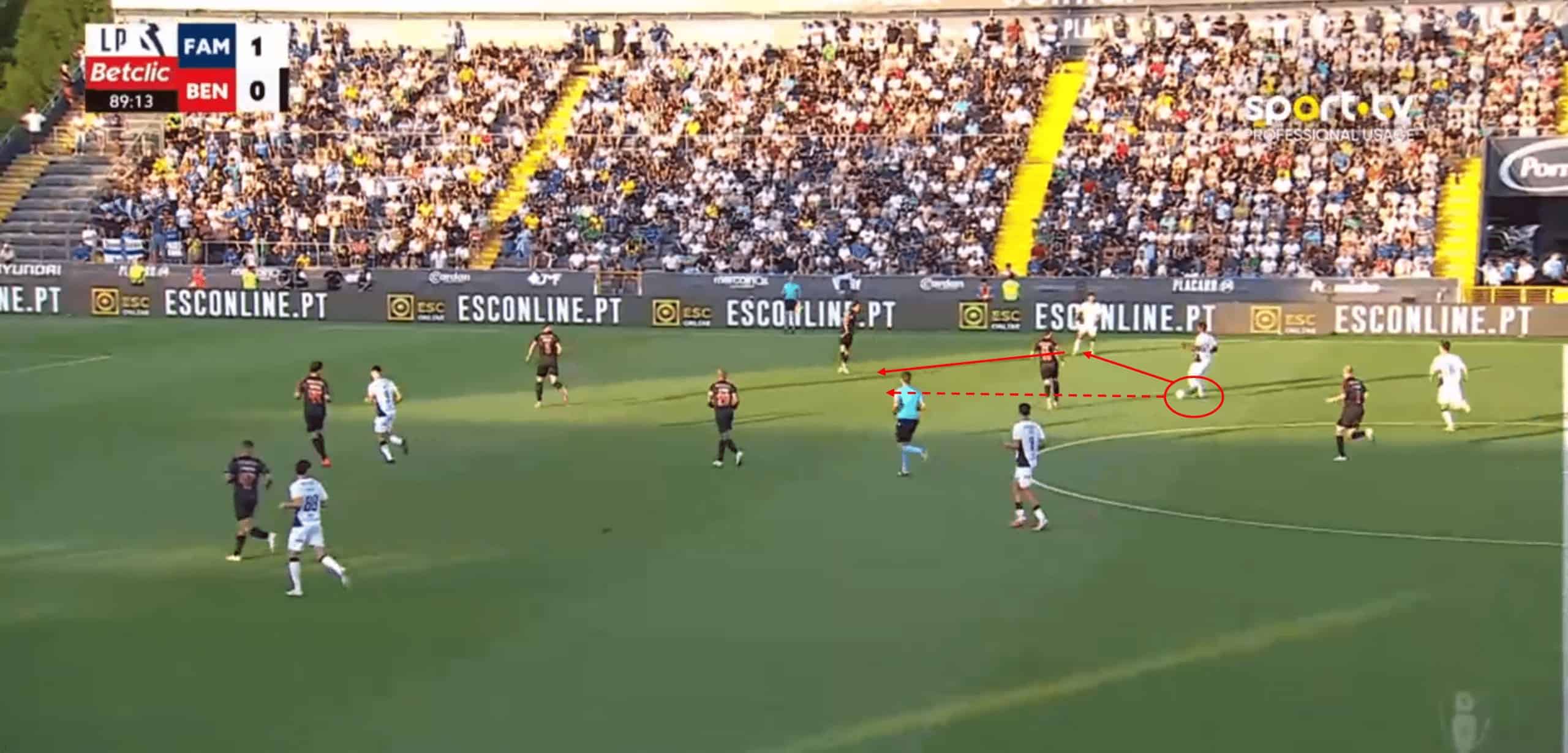
In the picture above, we can see Famalicão on the counterattack, with Youssouf having the ball and Benfica slowly dropping back to defend.
Youssouf now plays a pass to the right winger Gil Dias and instantly moves forward, building a triangle-like structure with just two players. This allows them to progress the ball through two Benfica defenders.
This is the playing and moving principle used effectively.
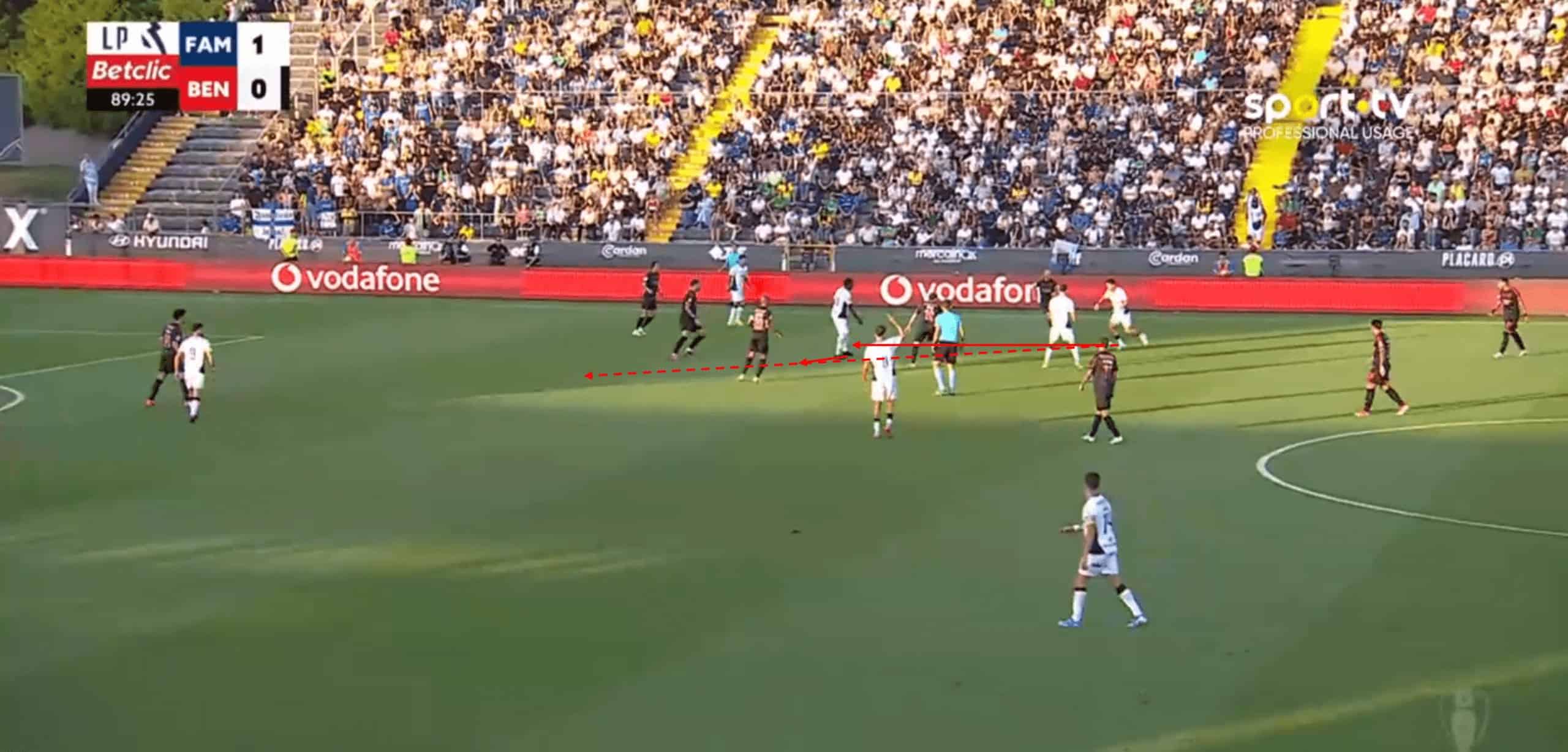
From then on, the two Famalicão players integrate the „steep-clap“ principle into the attack.
Dias plays a hard pass towards Youssouf, who is just letting the ball bounce with one touch right into the path of the moving Dias.
This allows them to progress the ball even further into Benficas’ half and allows Dias to dribble the ball into the box.
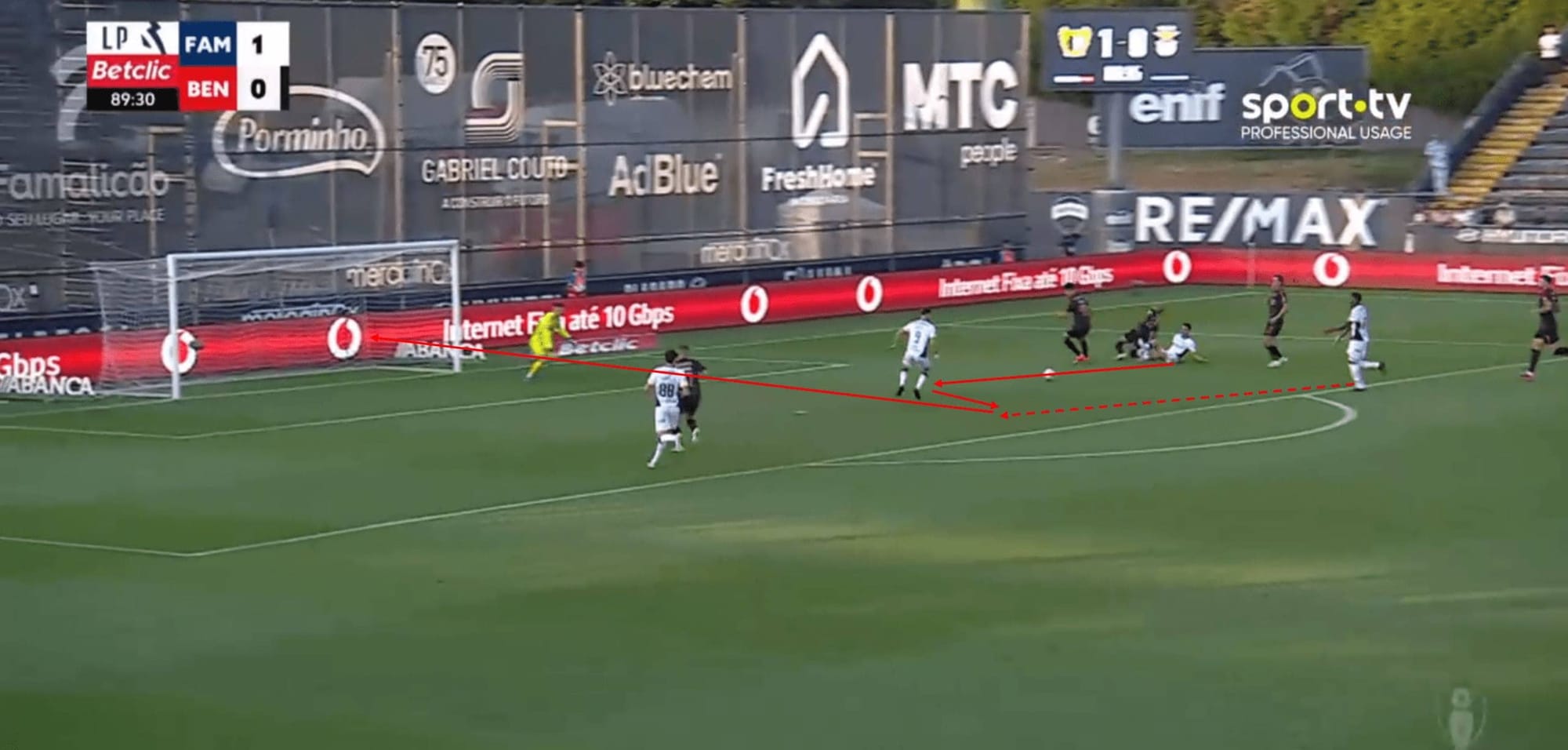
From there on, Benfica is scrambling to defend, leaving González wide open, who has the vision to see Youssouf making a run and playing the ball to him for an easy finish, 14 metres away from goal, all alone.
Throughout the entire sequence, Benfica was not able to win the ball or defend the dynamic players of Famalicão, resulting in the game-deciding goal.
These two simple principles allow Famalicão to play their counterattacks very efficiently, a stroke of genius by Evangelista.
Quick Build-Up
When not on the counter, FC Famalicão is prioritising a quick way in build-up play as well, the team is not focused on keeping possession, but on progressing the ball.
Most of the time, the centre-backs are triggering play with the first or second pass, sometimes by playing it out to the full-backs, who are pushing up the field, but most of the time, they are trying to find a pass to their strikers.
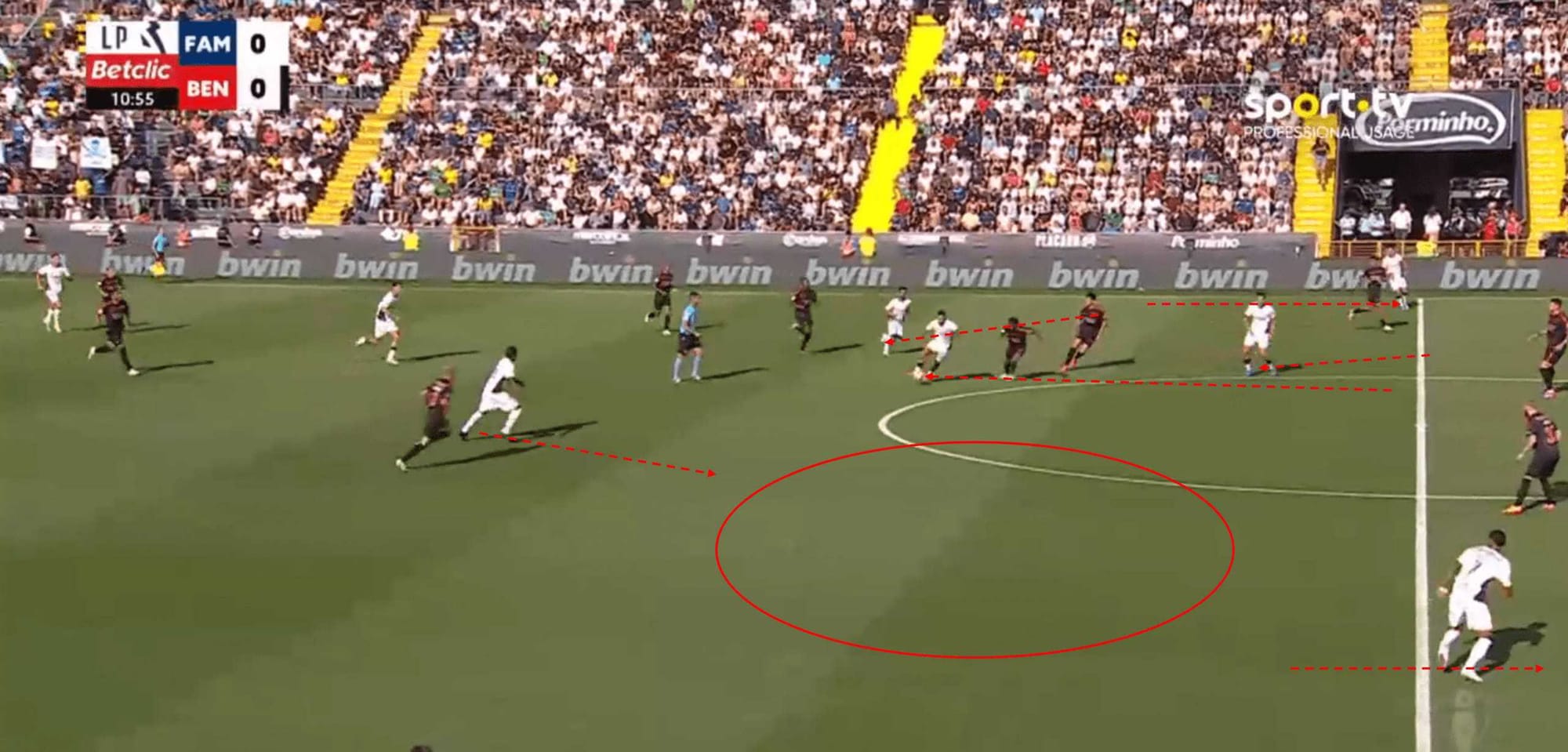
Here, we can see the build-up from Famalicão in full effect.
Both central midfielders are dropping deep, dragging the Benfica midfielders out of position.
The attackers are making runs into the vacated space, here centre-back de Haas plays a ball right towards striker Aranda.
Aranda then is able to turn and has multiple options now: He could pass the ball to Zaydou Youssouf, who is making a run into the vacated area in the half-space, or he could pick out one of the players making a run in behind the last line of Benfica.
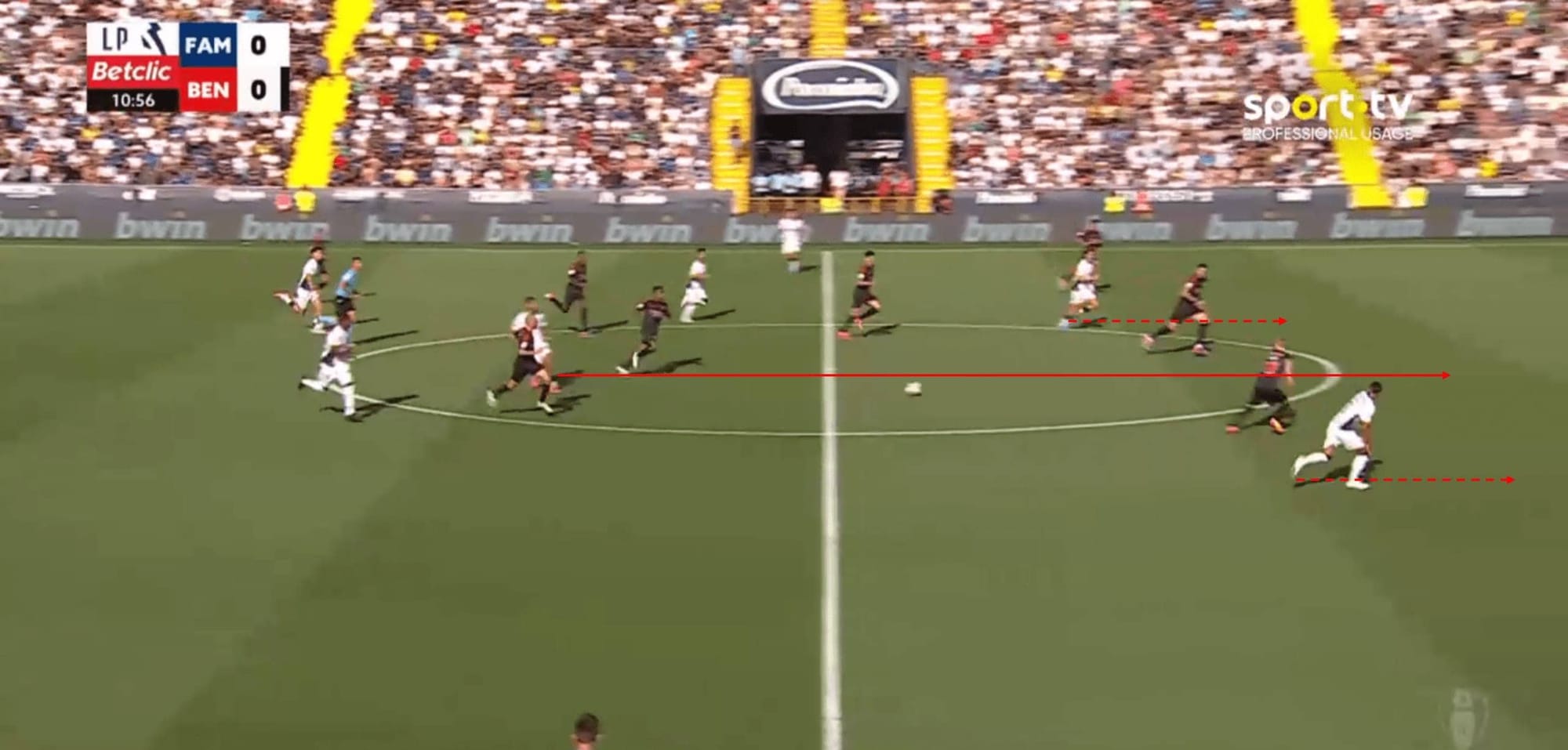
Aranda decides to do the latter and plays a pass right into the path of right winger Sorriso, who then is through on goal and keeps calm and collected, scoring the leading goal for Famalicão.
With the movement of his attackers, Evangelista enables his team to play two passes through the middle of the pitch to progress the ball from their own box to scoring a goal within not even ten seconds.
It’s simple football, but it’s working.
Obviously, it isn’t without risk, but even if his men lose the ball here, Evangelista knows he can count on his team to engage in their counterpressing and win the ball back fast.
Famalicão is great at creating dynamics out of nowhere.
Benfica’s defenders were caught off-guard in this situation, and it cost them.
The team might not be great with the ball or value possession as an important good, but they are definitely able to punish any mistake the defending team makes within an instant.
The focus on the middle of the field is also apparent in every situation. Famalicão is using the fewest crosses per game so far this season.
Key player: Gustavo Sá
We have talked a lot about FC Famalicão’s collective and how they are using that as a strength, but if a 19-year-old is taking this much responsibility in a team, you have to talk about him.
Gustavo Sá is a youth product at Famalicão.
He made his breakthrough into the first team last season, becoming a starter for the majority of the year and even captaining the team multiple times during his first year as a starter.
Why is Gustavo Sá the critical player for Armando Evangelista?
He triggers the press.
Most of the joyous situations we have taken a look at during this article have been the result of the actions of the young attacking midfielder.
Sá shows a great footballing IQ in pretty much every single situation, triggering the press at the right times and also being maybe the most important part of the press, winning a lot of the balls up the field.
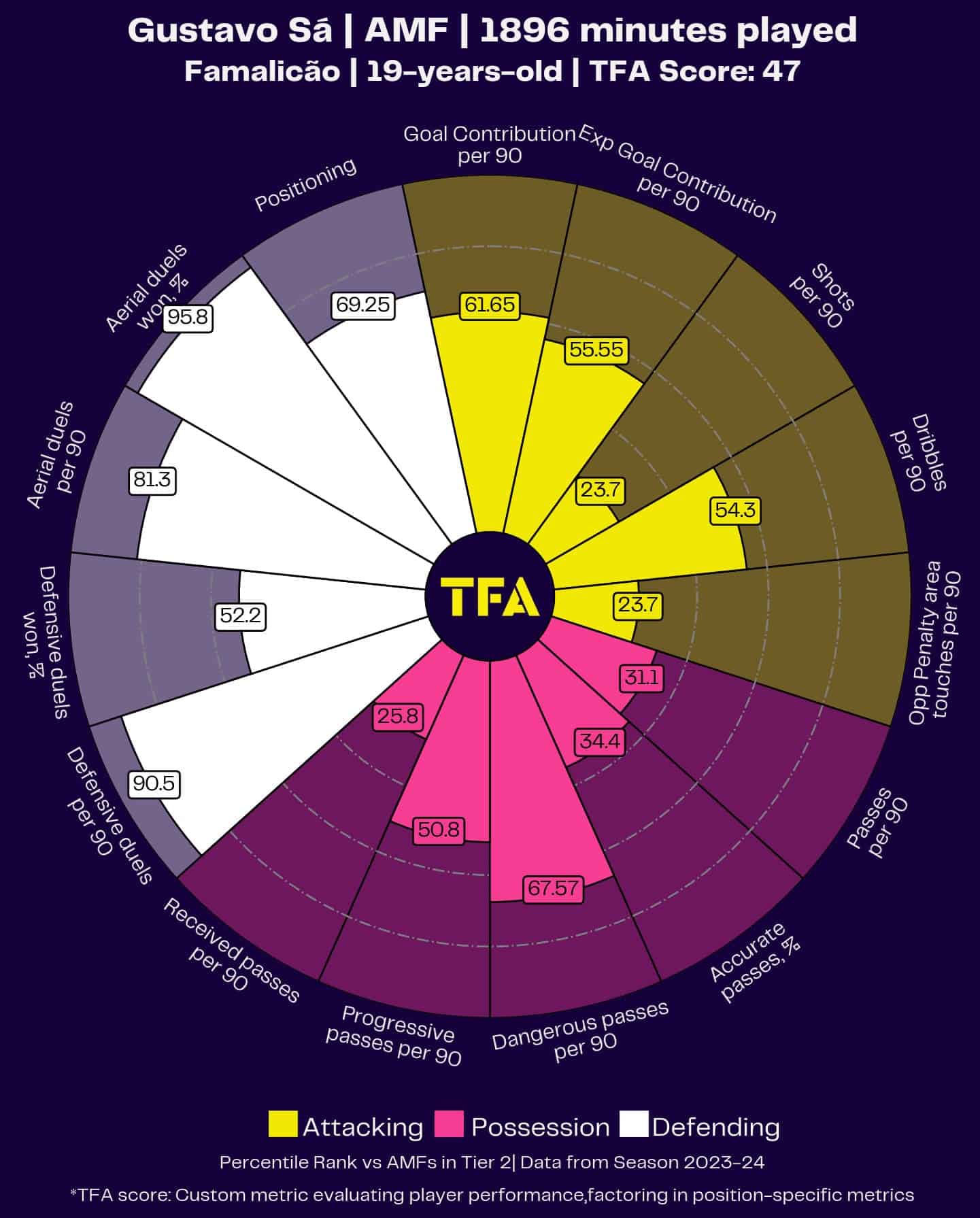
Taking a look at the statistics, it’s obvious why Evangelista puts so much trust in the young midfielder.
While many attacking players coming out of the academies these days are struggling with defending at the professional level, Sá has been amazing against the ball from the get-go, ranking in the 91st percentile in terms of defensive duels per 90.
Sá really hunts down the ball in pressing, taking on a lot of duels and forcing opposing defenders into mistakes in the build-up in every game he plays in.
Gustavo Sá is also the most creative player on the team, and his teammates trust him a lot with the ball.
While the statistics do not look too good yet, he still ranks in the 68th percentile in terms of dangerous passes per 90 minutes, in the 62nd percentile of goal contributions per 90 and in the 55th percentile of dribbles per 90.
In the game against Estrela, his individual class was also the deciding factor for the first goal. He took on three defenders and squared the ball to Sorriso for the tap-in finish.
Another very interesting thing about Sá is his aerial ability.
Not only does he take a lot of aerial duels (82nd percentile in aerials per 90), but he also ranks in the 96th percentile of aerials won per 90, which shows his ability as a target man for the long balls played in the quick build-up his coach implemented.
With just 19 years of age, there still is a lot of room to grow for Gustavo Sá, and if he can find more consistency in his passing game and shot creation, he can become the X-factor this team needs this season.
Conclusion
After finishing the season strongly, FC Famalicão once again faced a difficult summer transfer window in which they lost key players.
However, with a very good recruitment strategy, they managed to put together a very fitting team for coach Armando Evangelista‘s playstyle.
During the first two games of the season, the team was absolutely crushing their opponents with their intense press and counter press, creating high-paced games in which they showed the great defensive ability of the team and have been very efficient going forward.
A good start to the season is nice, but the playstyle that Evangelista wants to see from his men is physically demanding, and it will be interesting to see if FC Famalicão can keep up the pace over the course of an entire season.
Another problem they will face is breaks.
As highlighted in this piece, Famalicão is very dependent on their collective pressing and the past has shown that even small breaks can cause cracks in the collective aggressive mindset of teams.
It will be interesting to see how Evangelista and his coaching staff will cope with that.
A player to watch this season is Gustavo Sá.
The teenager is already one of the most important players for his boyhood club and will only continue to improve.
With his talent, there is a good chance he will become one of the best players in the league this season.
Watching FC Famalicão this season so far has given me flashbacks of BVB under Jürgern Klopp at the start of the 2010s.
High-paced football with a focus on pressing and fast attacks, it’s just fun to watch the team play right now.
Hopefully, we will get to see a lot more of that in the coming months.






Comments